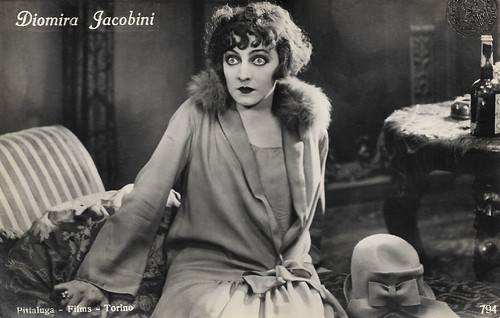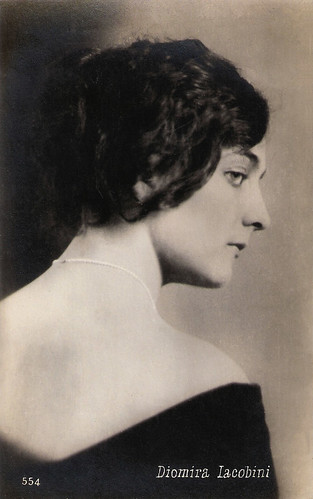
German postcard by Ross Verlag, no. 3748/1, 1928-1929. Source: Terra-Film. Diomira Jacobini in Revolutionshochzeit//The Last Night (A.W. Sandberg, 1928).

Italian postcard, no. 248. Photo: Bettini, Roma.

Italian postcard. Photo: Fert Film. Diomira Jacobini in L'isola della felicità/The Island of Happiness (Luciano Doria, 1921). Caption: Towards new happiness.

Italian postcard by Ed. A. Traldi, Milano, no. 792. Photo: Pitaluga-Films, Torino (Turin).

Italian postcard by Ed. A. Traldi, Milano, no. 793. Photo: Pittaluga-Films, Torino (Turin).

Italian postcard by Ed. A. Traldi, Milano, no. 794. Photo: Pittaluga-Films, Torino. Perhaps this card refers to Der Trödler von Amsterdam/The Dealer from Amsterdam (Victor Janson, 1925). The plot deals with a poor old dealer, Arent van Bergh (Werner Krauss), whose only friend is Oliver, a young philosopher (Alf Blütecher). The dealer's daughter Annette (Diomira Jacobini) wants to escape the black hole she lives in and is easily won over by a friend to explore the sinful places of the city, where she becomes infatuated with a wild criminal (Anton Pointner). With Oliver's help, the dealer will unmask the criminal as a ruthless murderer, which will open Annette's eyes.
A scandal in the noble family
Diomira Jacobini was born in Rome, Italy in 1896. She was the niece of a Vatican-based cardinal. When her older sister, Maria Jacobini, chose to work as an actress in the young film industry, it caused a scandal in the noble family.
The young Diomira decided to follow in her sister’s footsteps. She started to work for the prestigious Cines film studio in Rome. There she first appeared in such short films as Anna Maria/For Her Father's Sake (1912) with Ida Carloni Talli. Her name was included in the title when she appeared in the short comedy Le birichinate di Kri Kri e Diomira/Bloomer and Diomira at Play (1913) featuring Raymond Dandy, whose comic character Kri Kri was very popular at the time. According to Wikipedia, Jacobini had her first starring role in Il piccolo mozzo/The small hub (Carmine Gallone, 1915).
In the same year, she participated next to Lyda Borelli in Marcia nuziale/Wedding March (Carmine Gallone, 1915) in which she had one of her finest and prettiest parts. For the Celio film company, she co-starred with her sister Maria and another diva, Leda Gys in Ananka/Fate (1915), directed by Maria’s fiancé Nino Oxilia.
In 1916, she moved on to Tiber Film. For the Tiber studio, Jacobini made many films. Under the direction of Emilio Ghione, she made La rosa di granata/The Rose of Granada (Emilio Ghione, 1916) with Ida Carloni Talli and Lina Cavalieri.
Other films were Tormento gentile/Kind Torment (Emilio Ghione, 1916) with Alda Borelli, and Il figlio dell'amore/The Love Child (Emilio Ghione, 1916). A success was Demonietto/Imp (Gennaro Righelli, 1917). The male lead of this film was played by Alberto Collo, who would also be her co-star in several other films.

Italian postcard by Ed. A. Traldi, Milano, no. 525.

Italian postcard by IPA CT Duplex, no. 5111. Photo: Tiber Film. Tullio Carminati and Diomira Jacobini in L'aigrette/The Egret (Baldassarre Negroni, 1917), based on the play by Dario Niccodemi. Caption: Enrico and his fiancee, the duchess of Frontenac.

Italian postcard. Around 1917-1918, after they acted together in L'aigrette (1917), Diomira Jacobini and Tullio Carminati acted together a few times at Tiber Film, but with Jacobini always in supporting parts, e.g. in La via della luce (1917) with Hesperia, and La via più lunga (1918) starring Maria Jacobini.

Italian postcard. Photo: Fert Film. Diomira Jacobini and Alfonso Cassini in L'isola della felicità/The island of happiness (Luciano Doria, 1921). Caption: The happiness of a simple life.

Italian postcard by Ed. Traldi, Milano, no. 795. Photo: Pittaluga Films, Torino.

Vintage postcard. Photo: Fox / Deutsche Vereins-Film AG (Defa-Deutsche Fox). Diomira Jacobini in the German Fox production Der Trödler von Amsterdam/The Dealer from Amsterdam (Victor Janson, 1925).
A deep crisis
After finishing her engagement at Tiber Film, Diomira Jacobini signed a contract with Fert Film. The 1920s were less satisfactory for the actress, although she could show her talents successfully in films like La rosa di Fortunio/The Rose of Fortunio (Luciano Doria, 1922), Jolly, clown da circo/Jolly, circus clown (Mario Camerini, 1923) and La casa dei pulcini/The House of Pulcini (Mario Camerini, 1924) with Amleto Novelli.
She also starred opposite the popular ‘forzuto’ (strongman) Bartolomeo Pagano in the action film Maciste e il nipote d'America/Maciste and the nephew from America (Eleuterio Rodolfi, 1924).
At that time, the Italian film industry was in a deep crisis and only a few films were produced. Some of the best film actors and directors went to work abroad. Maria Jacobini was already working in Germany. There, Diomira co-starred with Werner Krauss in Der Trödler von Amsterdam/The junk dealer of Amsterdam (Victor Janson, 1925) and in some other films.
In Germany, she also appeared in Revolutionshochzeit/The Last Night (A.W. Sandberg, 1927) opposite Gösta Ekman. In the 1930s, she returned to Italy and worked again at Cines, where she acted in Il buon ragazzo/The good boy (Mario Camerini, 1930).
She made only two sound films: L'ultima avventura/The Last Adventure (Mario Camerini, 1932) starring Armando Falconi, and Cento di questi giorni/Hundred of these days (Augusto and Mario Camerini, 1933). Then she retired to private life with her husband L. Ghezzi. However, she participated in Quando eravamo muti/When we were silent (Riccardo Cassano, 1935). Diomira Jacobini died in 1959 in Rome.

Danish postcard by Alex. Vincent's Kunstforlag, Eneret, no. 253. Photo: Gösta Ekman and Diomira Jacobini in Revolutionshochzeit/The Last Night (A.W. Sandberg, 1927).

Danish postcard by Alex. Vincent's Kunstforlag, Eneret, no. 254. Photo: publicity still for Revolutionshochzeit/The Last Night (A.W. Sandberg, 1927). This was a German dramatisation of Sophus Michaëlis' play 'Revolutionshochzeit' (Revolutionary Wedding), with ;Gösta Ekman, Karina Bell, Walter Rilla and Fritz Kortner, and produced by Terra-Filmkunst.

Italian postcard, even if with French written captions, no. 52. Photo: Prod. Cines - Pittaluga. Diomira Jacobini and Armando Falconi in L'ultima avventura/The last adventure (Mario Camerini, 1932).

Italian postcard, even if with French written captions, no. 64. Photo: Prod. Cines - Pittaluga. Diomira Jacobini and Carlo Fontana in L'ultima avventura/The last adventure (Mario Camerini, 1932).

Italian postcard by Stab. Fotografico G.B. Falci, Milano, no. 88. Photo: Production Cines Pittaluga. Armando Falconi and Diomira Jacobini in L'ultima avventura/The last adventure (Mario Camerini, 1932).

Italian postcard by Ed. Ballerini & Fratini, Firenze, no. 554.
Sources: Treccani.it (Italian), Wikipedia (Italian), and IMDb.
No comments:
Post a Comment